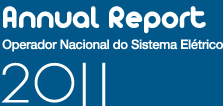Moving to New Facilities
ONS initiated in 2009 the process of changing its facilities in Rio de Janeiro, Recife and Florianópolis, considering projections about its future and growth estimates for 2020. As a starting point, it was made a detailed study of the structure available in the current buildings and carried out several planning meetings for the development and validation of a plan of organization's needs.
The locations of the new facilities were chosen: the neighborhood of Cidade Nova, in Rio de Janeiro, the neighborhood of Santo Amaro, in Recife, and Office Park complex, in Florianopolis. The buildings are under construction according to lease contracts that ONS signed with their owners-entrepreneurs.
The new facility will house research environments in Central Office and Regional Centers, and operating environments, in Regional Operation Centers, which imposes specific requirements for redundancy and reliability to ensure proper operation. The buildings will be constructed with the use of eco-friendly environments, reducing the impact on the environment, being given to the buildings a green building certification in basic category. Energy efficiency practices and reuse of water also contribute to reducing costs of operation and maintenance, in favor of tariff modicity.
The agreements were made in the modality built to suit, a form of contract which clauses involve legal, commercial and technical peculiarities. These transactions are ruled by Atypical Leasing Contracts (CLA) which have as attachment a Descriptive Memorial in which are established the details of the basic supply, appropriate to the needs of the Operator. Complementing the basic supply, ONS requires for its operation that several other requirements are met. In qualitative terms, these items are quite similar for each of the three new buildings.
Taking into account the importance that ONS meets the contractual responsibilities taken, ensures adherence to the contracted provision and has all its requirements met in the supply, some contracts of additional services were made, since this expertise is not available in the Operator’s staff.
To manage the implementation of new facilities in the three locations, it was established an advisory model that included the identification of the support structure for monitoring and control of events and contractual stages for the construction of the buildings, implementation of special infrastructure items, management of the physical moving to the new buildings and devolution of the buildings currently occupied to their owners. This structure comprises three specific functions: Additional Supply Manager, which is the entrepreneur itself in each building to avoid dilution of responsibilities, the Commissioning Manager, which is responsible for the technical and economic analysis of the works and the acceptance of facilities and the Project Manager Officer (PMO), assisting ONS in the global management of the processes.
Functional characteristics of the enterprises
The buildings were designed observing the horizontality of office spaces, emphasizing the integration of work groups and functionality, with the support of infrastructure targeted to energy efficiency and sustainability, combined with the comfort of users.
Energy efficiency is ensured by facade coatings, air conditioning systems with modern chillers, air supply by the raised floor and local control of temperature and humidity, lighting systems dimmer and with high output lamps (LED), automatic elevators with call control. These features are aligned with green building certification, achieved by specialized projects, without increasing investment costs.
The purpose of sustainability will be achieved through systems that result in energy saving and reuse of water.
Once in all locations the facilities include office environments and operating environments, the new facilities will have several common features and dimensions, depending on the number of employees at each location.
These attributes will ensure future costs of O & M far below the current ones. . Also contributes to this reduction in costs the fact that the necessary infrastructure to support the features that will be installed in the buildings, regardless of their implementation dates, is already being considered from the beginning of the project, in order to avoid rework.
The Occupation Plan emphasizes the continued operation of the final activities of ONS, and because of that, the building infrastructure was designed within the discretion of duality and reliability of Uptime international standard, level TIER III, following practices adopted internationally in system operators facilities.
In December 2011 in the building of Rio de Janeiro, 70% of the infrastructure stage had already been deployed. In the buildings of Florianópolis and Recife, at the same time, electrical, plumbing and air conditioning finishing parts were already being installed. The civil works were already being completed as well. The buildings of Recife and Florianópolis should be available for occupancy in late 2012. The building of Rio de Janeiro should have started its occupation in the first half of 2013.
